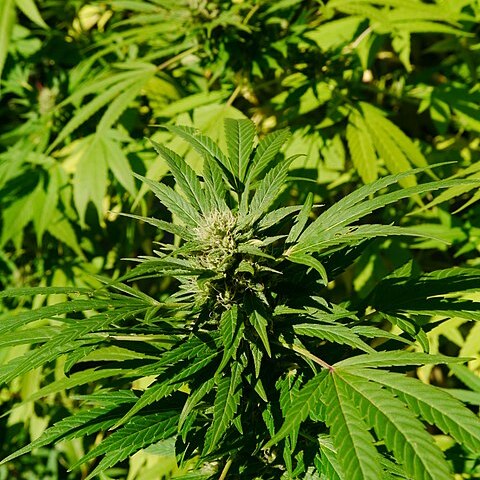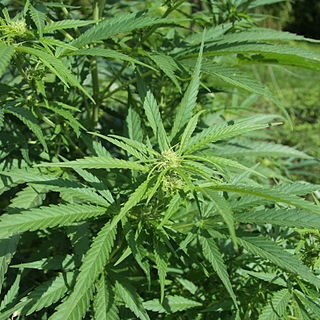Stem 1–3 m; lfls lance-linear to lance-elliptic, pubescent, 5–15 cm, toothed; achene in ours mostly 3.8–4.5 mm. Native of Eurasia, cult. in many parts of the world, and found here and there in our range. Late summer. Complex sp., differentiated under the influence of cult. into a northern subsp. sativa, used for production of fiber (hemp) from the bast, and a southern subsp. indica (Lam.) E. Small & Cronquist, harvested for an intoxicating, hallucinogenic drug in the epidermal resin glands. The crude flowering or fruiting material is marijuana; the extracted resin is hashish. Plants growing wild in our range are all or nearly all descended from plants formerly cult. for fiber, and the resin has a relatively small percentage of intoxicant. They may be referred to subsp. sativa var. sativa. Our plants appear to be in process of reversion toward the wild-adapted var. spontanea Vavilov (C. ruderalis), marked by its relatively small size, and more especially by its smaller (less than 3.8 mm), irregularly blotched achenes with a variable period of dormancy. Parallel vars. adapted to growth in cult. or in the wild exist in subsp. indica.
Stem slender, slightly angular, usually 1-1.5 m tall, sometimes much taller, rather densely appressed-pubescent when young. Stipules erect, filiform or narrowly subulate, ± 0.5 cm long. Leaves (3-)5—7(-11)-foliolate; upper ones often 1-foliolate. Leaflets sessile, narrowly lanceolate from a narrowed base, long-acuminate, acute, rather coarsely acutely serrate, on the upper surface very scabrid by short stiff hairs inserted on top of a cystolith (very conspicuous in dried leaves), on the lower surface appressed-pubescent and rather densely beset with sessile glands, 6-14 cm by 3-15 mm. ♂: Tepals oblong, greenish white with pellucid white margins, finely appressed-pubescent, ± 5 mm long. Anthers yellow, 3-4 mm. ♀: Enveloping bract on the back rather densely clothed with patent short, thick, glandular hairs, darkgreen, rather small during anthesis, afterwards much enlarged. Stigmas up to ½ cm long. Fruiting bract much contracted above the broad base, in the upper half with in-rolled margins, up to ¾ cm long. Fruit smooth, shining, yellowish or brown, ± 4-5 mm long. Seed containing oil.
Plants 1-3 m tall. Branchlets densely white pubescent. Stipules linear. Leaves alternate; petiole 2-7 cm; leaf blade abaxially whitish green, strigose, and with scattered brownish resinous dots, adaxially dark green and with cystolith hairs; leaflets usually lanceolate to linear, (3-)7-15 × (0.2-)0.5-1.5(-2) cm with longest in middle, margin coarsely serrate, apex acuminate. Male inflorescences ca. 25 cm. Male flowers: yellowish green, nodding; pedicel 2-4 mm, thin; sepals ovate to lanceolate, 2.5-4 mm, membranous, with sparse prostrate hairs; petals absent; filament 0.5-1 mm; anthers oblong. Female inflorescences crowded in apical leaf axils among leaflike bracts and bracteoles. Female flowers: green, sessile; calyx sparsely pubescent; ovary globose, ± enclosed by appressed calyx, surrounded closely by bract and bracteoles. Persistent bracts yellow. Achene flattened ovoid, 2-5 mm; pericarp crustaceous, finely reticulate. Fl. May-Jun, fr. Jul.
Staminate plants usually taller, less robust than pistillate plants. Stems 0.2-6 m. Leaves: petioles 2-7 cm. Leaflet blades mostly 3-9, linear to linear-lanceolate, 3-15 × 0.2-1.7 cm, margins coarsely serrate; surfaces abaxially whitish green with scattered, yellowish brown, resinous dots, strigose, adaxially darker green with large, stiff, bulbous-based conic hairs. Inflorescences numerous. Flowers unisexual, often transitional flowers and flowers of opposite sex developing later. Staminate flowers: pedicels 0.5-3 mm; sepals ovate to lanceolate, 2.5-4 mm, puberulent; stamens caducous after anthesis, somewhat shorter than sepals; filaments 0.5-1 mm. Pistillate flowers ± sessile, enclosed by glandular, beaked bracteole and subtended by bract; perianth appressed to and surrounding base of ovary. Achenes white or greenish, mottled with purple, ovoid, somewhat compressed, 2-5 mm, with ± persistent perianth that sometimes flakes off. 2 n = 20.
Annual herb, 1-2 m high; with simple or branched taproot, robust, stems angular, internodes often hollow; plants monoecious or dioecious. Leaves petiolate, membranous-chartaceous, both surfaces coarse-hairy and yellow-glandular; 3-7(-11)-foliolate, leaflets sessile, narrowly lanceolate, margins serrate-biserrate. Male inflorescences few-to ± 20-flowered, ± 200(-300) mm long; pedicellate; perianth lobes appressed-pubescent outside. Female inflorescences few-flowered, green. Fruit uniformly coloured, pale, prominent reticulate pattern of venation; if persistent perianth present, shiny, brownish or greyish, mottled with light and dark marbled pattern, venation visible beneath.
Usually dioecious, sometimes monoecious herb. Stem angular, fibrous, densely hairy, 0.3-2-(5) m high. Lvs with (3)-5-9-(11) leaflets; seedling lvs and upper cauline lvs with fewer leaflets; leaflets acute to acuminate, attenuate at base, moderately hairy beneath, sparsely to moderately hairy above with globose-based hairs and some glandular hairs. Petiole < or = lf blade. Stipules 2 per node. Bracts triangular, hairy, green. Calyx of ♀ fls with simple patent hairs and numerous glandular hairs; calyx of ♂ fls with numerous, simple patent hairs and few glandular hairs. Achene ovate-ellipsoid, greyish brown or greenish, variously marbled cream or brown, 2.5-5 mm long.
Plant to 4 (–6) m high. Stems with dense appressed hairs, scabrid. Leaves palmate. Leaflets 3–9 (–11), linear-lanceolate to very narrowly elliptic, 3–14 cm long (central leaflet the longest), serrate; margins slightly reflexed; upper surface with tubercle based hairs; lower surface with resinous granules; hairs dense, deflexed; stipules lanceolate; petiole to 9 cm long. Male flowers: stamens drooping. Female flowers: bracts glandular-hairy, ciliate; stigma 8–10 mm long, with unicellular hairs, exserted beyond bracts; bracts persistent. Achenes persistent on plant, c. 1.5 mm long, pale brown with dark brown blotching and reticulate venation.
Leaves 3–7(11)-digitately-foliolate; petiole 2–6 cm. long; stipule to 1.4 cm. long, linear, acute; leaflets sessile, 2.5–15 x 0.35–2 cm., narrowly lanceolate, tapering acuminate at the apex, narrowly cuneate at the base; margin coarsely dentate to serrate-biserrate; lamina membranous-chartaceous, shortly coarsely-hairy and yellow-glandular on both surfaces, penninerved, midrib prominent beneath.
Erect, annual, aromatic herb, up to 4 m high, with minute appressed glandular hairs on most parts of plant. Leaves 5-7-foliolate, blades of leaflets narrowly ovate. Flowers: female flowers without a perianth, but with ovary enclosed in a sheath-like bract copiously dotted with glands, secreting a narcotic resinous substance; green; Nov.-May.
An annual herb. It is about 2 m high. The leaves are alternate. They are divided like fingers on a hand and has 3-7 leaflets. The leaflets are sword shaped and have coarse teeth along the edge. They are rough in texture. The flowers are yellowish. Male and female flowers occur on separate plants. The fruit is a dry one seeded fruit.
An erect, rank smelling, annual herb up to 2(4.5) m. tall; male plants taller and more slender with longer narrower leaflets than the female, dying soon after flowering; female plants short, more robust, with densely leafy inflorescences, the plants living for several months after pollination.
Male flowers small, pedicellate, regular: pedicels to 7 mm. long; perianth lobes free, greenish or white, 3–4 x 1 mm., oblong-elliptic, boat-shaped, spreading or reflexed, appressed-pubescent outside; stamens at length pendulous, filaments 0.3–1 mm. long, anthers 3--mm. long.
Female flowers ± sessile; enveloping bracteole 2–8 mm. long, green; perianth thin, undivided, enveloping ovary and mature fruit (often reduced or absent in cultivated forms); ovary sessile, c. 1 mm. in diam., ± globose; stigma branches (1)2–5 mm. long, pubescent, caducous.
Fruit 3–4 x 2–3.5 mm., globular to ovoid, surface uniformly coloured, pale with a prominent reticulate pattern of venation or, where a persistent perianth is present, shiny brownish or greyish, mottled with a light and dark marbled pattern, venation visible beneath.
Erect annual herb, up to 4 m high. Leaves with 5-7 lobes. Female flowers without a perianth but with ovary enclosed in a sheath-like bract copiously dotted with glands, secreting a narcotic resinous substance. Flowers green.
Male inflorescences numerous, loosely cymose-paniculate, sparsely leafy, up to 20(30) cm. long, few to more than 20-flowered; bracts to c. 15 mm. long, bristly-hairy.
Female inflorescence short, crowded or strobilate, few-flowered, densely leafy; bracts often shorter than in male flowers.
Indumentum of most parts consisting of minute appressed swollen-based hairs.
Male and female flowers rarely both on 1 plant, if so then 1 predominating.
Stems simple or branched, leafy, angular, often with hollow internodes.


